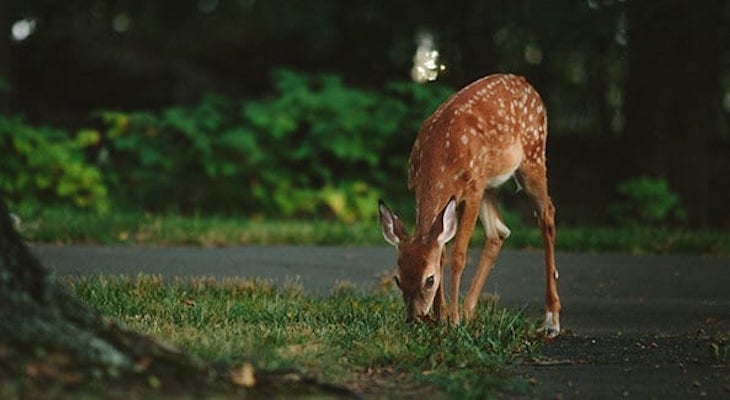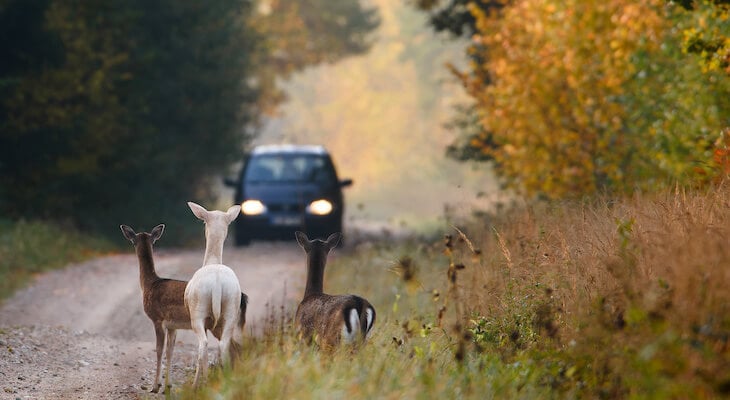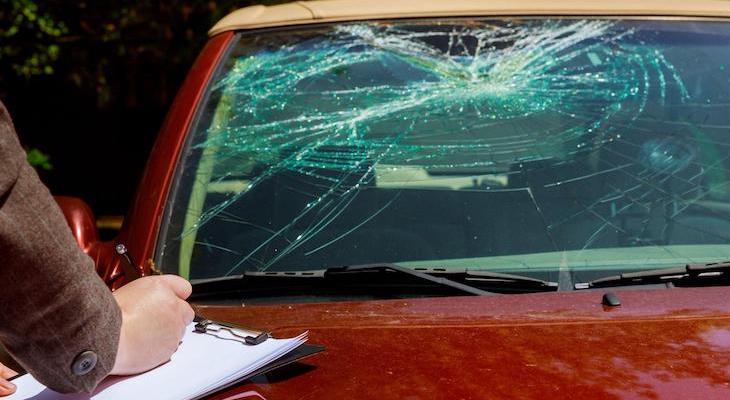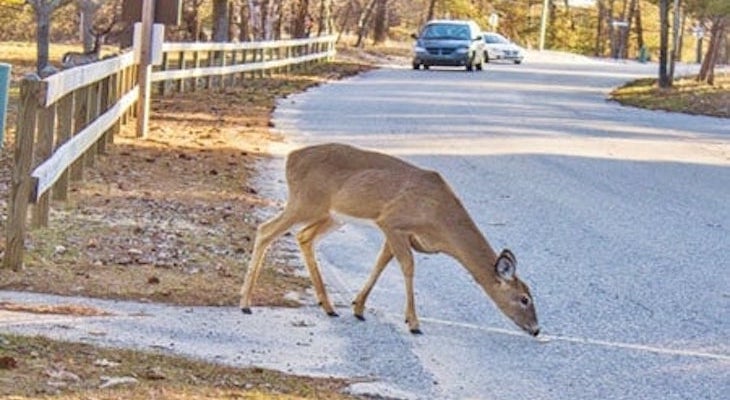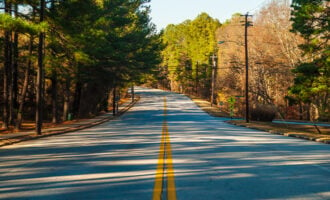What to Do If You Hit a Deer: Car Accident Next Steps
At Compare.com, it’s our mission to find simple ways to help our customers save money on the things they need. While we partner with some of the companies and brands we talk about in our articles, all of our content is written and reviewed by our independent editorial team and never influenced by our partnerships. Learn about how we make money, review our editorial standards, and reference our data methodology to learn more about why you can trust Compare.com.
A century ago, white-tailed deer were rare on the East Coast. Now, the deer population totals more than 25 million, and they’re everywhere: in backyards, parks, and roads. Collisions with deer cause 200 human deaths and cost more than $4 billion per year.
Don’t assume it won’t happen to you! Deer car accidents are more common than you think.
If you are dealing with a deer accident and considering a new insurance provider, we recommend shopping around to receive quotes from multiple providers. To find the best car insurance rates, enter your ZIP code below:
Unlock your cheapest rates for free
What to Do if You Hit a Deer: 4 Steps
The first step is staying calm and aware of your surroundings in the immediate aftermath.
Here are the first steps to take immediately after a deer accident.
1. Pull Over to the Side of the Road
Move your vehicle to the side of the road and out of harm’s way. Do not approach the deer, which may be wounded and in a heightened state of fear. Instead, turn on your hazard lights and check immediately if you or your passengers have sustained injuries. Seek medical attention immediately for anyone who needs it.
2. Call Authorities and Document the Incident
Next, file a police report:
- Call the police and provide your location.
- Inform the police if the deer is affecting road traffic or poses a safety threat to others.
- If you or your passengers have sustained injuries, ask the police to call an ambulance.
Document the incident by taking pictures and videos of all injuries and vehicle damage. Capture footage from multiple angles. Do not forget to snap leaking fluid and all loose parts. If witnesses are at the scene, document their account of what transpired and collect their contact information.
The better your visual proof of damage, the easier it is to file your insurance claim. It will also help you evaluate the quality of repairs later. The law requires your insurance company to return your vehicle to its pre-loss condition.
3. Determine if Your Vehicle is Safe to Drive
After documenting the incident, confirm that your vehicle is safe to drive by checking for leaking fluid, loose parts, deployed airbags, and other safety hazards preventing you from driving.
If your vehicle is unsafe to drive, call for a tow truck. Your policy may provide roadside assistance with a tow truck reimbursement. You may have also opted for a third-party tow truck service (e.g., through your leasing company). For example, car maker Genesis offers a 3-year complimentary 24/7 Roadside Assistance plan that provides free tire changes and tow to the nearest dealership or authorized service provider.
4. Call Your Insurance Company
After filing the police report, call your insurance company right away. The sooner you report the incident, the better. Your insurance company will go over all coverage options with you and walk you through the steps of filing a claim.
Note: Comprehensive coverage covers deer crashes, not collision coverage. Collision coverage covers damage to your vehicle in an accident involving another car. Comprehensive coverage, on the other hand, pays for vehicle damages sustained by covered events (e.g., theft, hail, and deer). Both are considered optional coverage, so review your current policy with an agent following an accident.
How Does Hitting a Deer Affect Your Car Insurance?
According to Allstate, deer collisions are typically a covered loss. Read your comprehensive coverage policy to see if animal collisions are covered. If there’s no physical contact with the deer (e.g., you swerve and hit a tree), it will probably be considered a collision loss. But if you only have basic liability coverage, you’ll likely have to cover the entire repair bill out of pocket.
The average cost of a deer crash? According to State Farm, it’s $3,900. The good news is that insurers typically don’t hold U.S. drivers responsible for car accidents involving deer, so your rates are unlikely to increase.
When Do Deer Crashes Occur?
Deer car crashes are most common in October, November, and December, with November being the peak. This period is mating season, so deer tend to roam more. They can also be more prevalent in late spring and early summer when young deer establish new territory for themselves.
Crashes occur most frequently at dawn and dusk, when a number of deer come out to feed. Lower visibility makes it more difficult for the driver to see them. So while they’re more common in rural areas, suburban crashes can happen as well — particularly as new development infringes on deer habitats.
The most common states for deer car accidents tend to be Midwestern or Appalachian, with Iowa, Pennsylvania, Michigan, Wisconsin, and West Virginia reporting the most deer-vehicle collisions per capita. However, crashes are also prevalent on the East Coast and in the Pacific Northwest, though to a much lesser extent.
How to Avoid a Deer Car Accident
Even though car accidents caused by deer are common, they’re not inevitable.
To avoid hitting a deer, you should:
- Be extra vigilant from October through early January.
- Watch out for deer when they’re most active, at dawn and dusk.
- Expect to see more deer if you spot one beside the road.
- Don’t swerve to avoid a deer, because you could hit other motorists.
- Use your high beams in deer crossings or rural areas if there’s no oncoming traffic.
- Slow down and flash your lights if you see a deer standing in the middle of the road.
- Don’t forget to wear your seat belt at all times.
Is it Better to Hit a Deer or Swerve to Avoid It?
If you see a deer ahead of you on the road, it’s important not to try to swerve out of its way. Deer car crashes cause approximately 200 fatalities per year, and many of them result from car crashes caused by the driver attempting to swerve. Instead, make sure to slow down, and if the deer refuses to move, simply prepare for impact.
Shop Around for the Best Car Insurance Rates
One of the best things you can do to prepare for a potential deer accident is call your insurance agent and request comprehensive insurance.
Comprehensive coverage helps cover damages caused by non-vehicle collision-related accidents, such as contact with animals, vandalism, and fallen objects such as tree branches.
If your current insurance policy does not have affordable comprehensive coverage, now may be the best time to look into other auto insurance providers. We recommend shopping around for car insurance, especially as your life circumstances change. You never know if other insurance companies are lowering their premiums while your current insurance company raises theirs.
Compare all of your options by entering your ZIP code below:
Compare Rates from Dozens of Companies
Compare Car Insurance Quotes
About Compare.com
Compare.com’s #1 goal is to save you money. We publish resources that are based on hard-hitting data and years of industry experience to help you make more informed decisions with your wallet.
- All of Compare.com’s content is written and reviewed for accuracy by a team of experienced writers and editors who are experts on the topics they cover.
- None of Compare.com’s content is ever influenced by the companies and brands we partner with.
- Compare.com’s editorial team operates independently of any of the company’s partnership or business development interests. We publish unbiased information strictly for the benefit of our readers.
- All of the content you see on Compare.com is based on comprehensive analysis and all data is gathered and vetted from trustworthy sources.
Learn more about us, our team, and what makes us tick.
